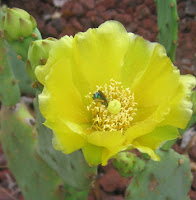What was All that BUZZZZ at the FNPS Conference?
 |
| Native metallic green bees go crazy in the prickly pear (Opuntia humifusa) flowers. |
On Friday during lunch, Tracy McCommon, of Nature Wise TV, screened their video “Gardening for Native Pollinators of Florida,” which was so popular that they ran it again the next day. It’s for sale on their website, if you’d like a copy.
 |
| Stephen Buchmann makes apoint to a crowded room |
Friday afternoon Stephen L. Buchmann, author of “The Forgotten Pollinators,” gave his presentation, “Trouble in Paradise: Are we Losing our Native Bees?
 |
| Akers Pence of Uiversity of Florida studies our native bees |
It was good to have so much information about one topic--that way more information actually sinks in...
Here’s what I learned:
· There are 316 species of bees native to Florida
· Most of the native bees are solitary and shy.
· Female solitary bees dig long tunnels lined with excretions to make it waterproof, gather pollen in their branched hairs and deposit the pollen ball in a side tunnel, lay an egg on it and repeat 20 or thirty times. After laying all her eggs the female seals up the tunnel with a plug of soil. (Sometimes the "cowbirds" of the bee world wait for the female to leave the tunnel, go in and lay their own egg on the pollen sac.)
· Leaf cutter bees cut perfect circles from leaves and use them to wrap the pollen ball and an egg. Think of them as “ba-bee” blankets.
· Other native bees carve nests into wood.
The difference between a wasp and a bee is
1) the diet—most wasps are carnivorous, while bees exist on pollen and nectar.
2) the branched hairs—bees have them to collect the pollen, wasps do not.
 |
| A carpenter bee has hairs on its legs to gather pollen for its young. |
 |
| A wasp does not have hairs to carry pollen. |
What we can do to encourage our native bees:
· stop using pesticides.
· leave bare soil in undisturbed areas so bees can dig their tunnels.
· leave some snags, stumps and logs so the wood borers have a place to next.
· And, of course plant native plants that the bees love.
Resources:
The extreme details of bees of Florida: www.bio.georgiasouthern.edu/Bio-home/Pascarella/Intro.htm
Native pollinators being studied in Florida: www.panhandlefresh.com/articles/Pollinators.pdf
The great sunflower project is asking for citizen scientists to analyze bees that visit the same type of sunflower on a nationwide basis. Their website also has lots of information: www.greatsunflower.org
Ginny Stibolt



Comments
Sustainable gardeners will want to attract both bees and wasps to their landscapes for the pollination services.